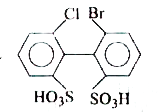Which of the following will show optical activity?
Cis−[Co(NH3)2(en)2]3+
Trans−[Co(NH3)2(en)2]3+
[Co(NH3)6]3+
Trans−[Co(H2O)4CI2]+
The correct Answer is:A
To determine which of the given coordination compounds will show optical activity, we need to analyze their structures and symmetry. Optical activity occurs when a compound has non-superimposable mirror images, meaning it does not possess a plane of symmetry.
1. Identify the Ligands and Coordination Number:
- The question involves coordination compounds with different ligands. We need to identify whether the ligands are monodentate or bidentate.
- Monodentate ligands bind through a single donor atom, while bidentate ligands can bind through two donor atoms.
2. Draw the Structures:
- For the complex with a monodentate ligand (like amine) and a bidentate ligand (like ethylene diamine), we can visualize the structure in an octahedral geometry.
- Place the central metal ion (e.g., cobalt) at the center and arrange the ligands accordingly. In the cis configuration, the monodentate ligands will be adjacent to each other.
3. Check for Optical Isomers:
- Draw the mirror image of the structure. If the mirror image cannot be superimposed on the original structure, it indicates the presence of optical isomers.
- For the cis configuration with one monodentate ligand and one bidentate ligand, the mirror images will not be superimposable, indicating optical activity.
4. Analyze Other Configurations:
- For the trans configuration with only monodentate ligands, the structure will have a plane of symmetry. The mirror image will be superimposable, indicating that it is optically inactive.
- Similarly, if a complex contains only one type of ligand, it will also lack optical isomers due to symmetry.
5. Conclusion:
- After analyzing the structures and their mirror images, we conclude that the complex with the cis configuration of a monodentate and a bidentate ligand shows optical activity, while the others do not.
Final Answer:
The correct option that shows optical activity is Option A.
- The question involves coordination compounds with different ligands. We need to identify whether the ligands are monodentate or bidentate.
- Monodentate ligands bind through a single donor atom, while bidentate ligands can bind through two donor atoms.
- For the complex with a monodentate ligand (like amine) and a bidentate ligand (like ethylene diamine), we can visualize the structure in an octahedral geometry.
- Place the central metal ion (e.g., cobalt) at the center and arrange the ligands accordingly. In the cis configuration, the monodentate ligands will be adjacent to each other.
- Draw the mirror image of the structure. If the mirror image cannot be superimposed on the original structure, it indicates the presence of optical isomers.
- For the cis configuration with one monodentate ligand and one bidentate ligand, the mirror images will not be superimposable, indicating optical activity.
- For the trans configuration with only monodentate ligands, the structure will have a plane of symmetry. The mirror image will be superimposable, indicating that it is optically inactive.
- Similarly, if a complex contains only one type of ligand, it will also lack optical isomers due to symmetry.
- After analyzing the structures and their mirror images, we conclude that the complex with the cis configuration of a monodentate and a bidentate ligand shows optical activity, while the others do not.
The correct option that shows optical activity is Option A.
Topper's Solved these Questions
- ALCOHOLS, PHENOLS AND ETHERSBOOK - AAKASH INSTITUTE ENGLISHCHAPTER - ALCOHOLS, PHENOLS AND ETHERSEXERCISE - Try yourself
5 Videos
- ALCOHOLS, PHENOLS AND ETHERSBOOK - AAKASH INSTITUTE ENGLISHCHAPTER - ALCOHOLS, PHENOLS AND ETHERSEXERCISE - Exercise
40 Videos
- ALCOHOLS, PHENOLS AND ETHERS BOOK - AAKASH INSTITUTE ENGLISHCHAPTER - ALCOHOLS, PHENOLS AND ETHERS EXERCISE - Try Yourself
5 Videos
Similar Questions
Knowledge Check
Which of the following will show optical isomerism?
A B
B C
C D
D
Which of the following will show optical isomerism?
View SolutionWhich of the following is not optically active?
View SolutionWhich of the following is not optically active?
View SolutionWhich of the following does not show optical activity ?
View SolutionWhich of the following is optically active?
View SolutionWhich of the following is/are optically active?
View SolutionWhich of the following is optically active
View Solution
